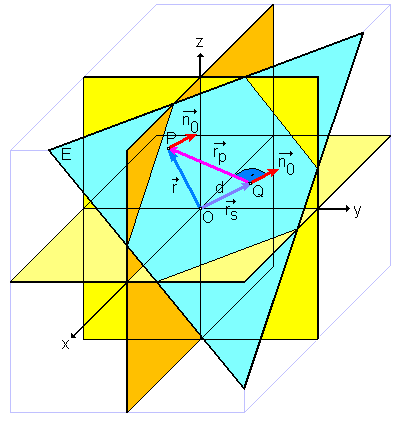Hesse normal form
The Hesse normal form named after Otto Hesse, is an equation used in analytic geometry, and describes a line in [math]\displaystyle{ \mathbb{R}^2 }[/math] or a plane in Euclidean space [math]\displaystyle{ \mathbb{R}^3 }[/math] or a hyperplane in higher dimensions.[1][2] It is primarily used for calculating distances (see point-plane distance and point-line distance).
It is written in vector notation as
- [math]\displaystyle{ \vec r \cdot \vec n_0 - d = 0.\, }[/math]
The dot [math]\displaystyle{ \cdot }[/math] indicates the scalar product or dot product. Vector [math]\displaystyle{ \vec r }[/math] points from the origin of the coordinate system, O, to any point P that lies precisely in plane or on line E. The vector [math]\displaystyle{ \vec n_0 }[/math] represents the unit normal vector of plane or line E. The distance [math]\displaystyle{ d \ge 0 }[/math] is the shortest distance from the origin O to the plane or line.
Derivation/Calculation from the normal form
Note: For simplicity, the following derivation discusses the 3D case. However, it is also applicable in 2D.
In the normal form,
- [math]\displaystyle{ (\vec r -\vec a)\cdot \vec n = 0\, }[/math]
a plane is given by a normal vector [math]\displaystyle{ \vec n }[/math] as well as an arbitrary position vector [math]\displaystyle{ \vec a }[/math] of a point [math]\displaystyle{ A \in E }[/math]. The direction of [math]\displaystyle{ \vec n }[/math] is chosen to satisfy the following inequality
- [math]\displaystyle{ \vec a\cdot \vec n \geq 0\, }[/math]
By dividing the normal vector [math]\displaystyle{ \vec n }[/math] by its magnitude [math]\displaystyle{ | \vec n | }[/math], we obtain the unit (or normalized) normal vector
- [math]\displaystyle{ \vec n_0 = {{\vec n} \over {| \vec n |}}\, }[/math]
and the above equation can be rewritten as
- [math]\displaystyle{ (\vec r -\vec a)\cdot \vec n_0 = 0.\, }[/math]
Substituting
- [math]\displaystyle{ d = \vec a\cdot \vec n_0 \geq 0\, }[/math]
we obtain the Hesse normal form
- [math]\displaystyle{ \vec r \cdot \vec n_0 - d = 0.\, }[/math]
In this diagram, d is the distance from the origin. Because [math]\displaystyle{ \vec r \cdot \vec n_0 = d }[/math] holds for every point in the plane, it is also true at point Q (the point where the vector from the origin meets the plane E), with [math]\displaystyle{ \vec r = \vec r_s }[/math], per the definition of the Scalar product
- [math]\displaystyle{ d = \vec r_s \cdot \vec n_0 = |\vec r_s| \cdot |\vec n_0| \cdot \cos(0^\circ) = |\vec r_s| \cdot 1 = |\vec r_s|.\, }[/math]
The magnitude [math]\displaystyle{ |\vec r_s| }[/math] of [math]\displaystyle{ {\vec r_s} }[/math] is the shortest distance from the origin to the plane.
References
- ↑ Bôcher, Maxime (1915), Plane Analytic Geometry: With Introductory Chapters on the Differential Calculus, H. Holt, p. 44, https://books.google.com/books?id=bYkLAAAAYAAJ&pg=PA44.
- ↑ John Vince: Geometry for Computer Graphics. Springer, 2005, ISBN:9781852338343, pp. 42, 58, 135, 273
External links
 |



